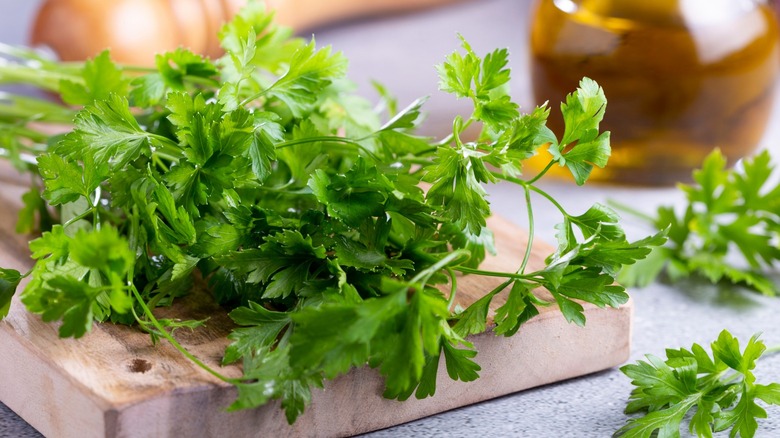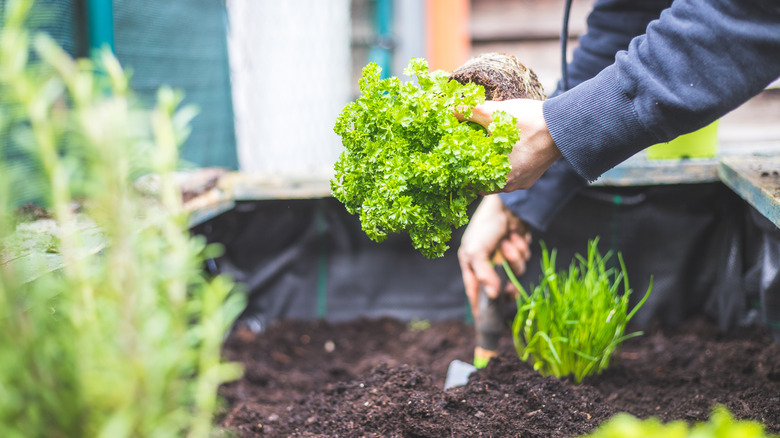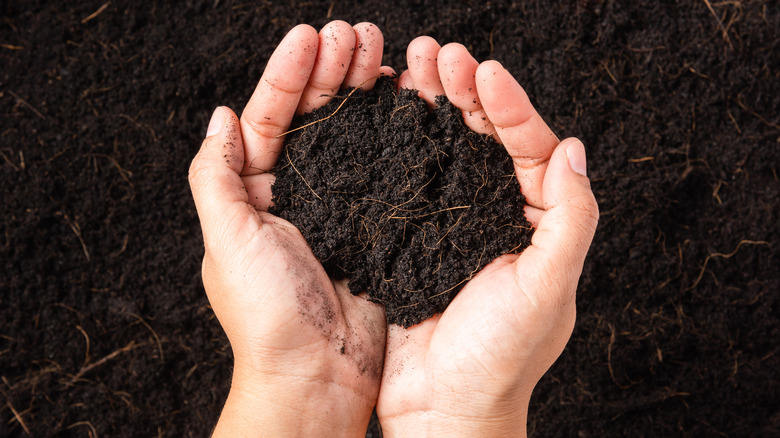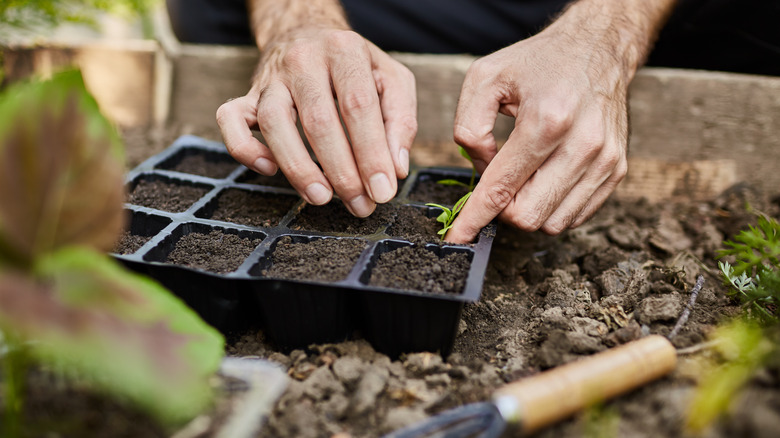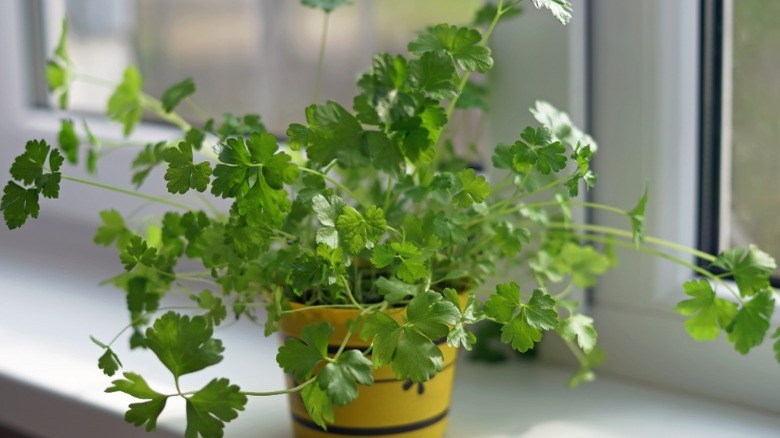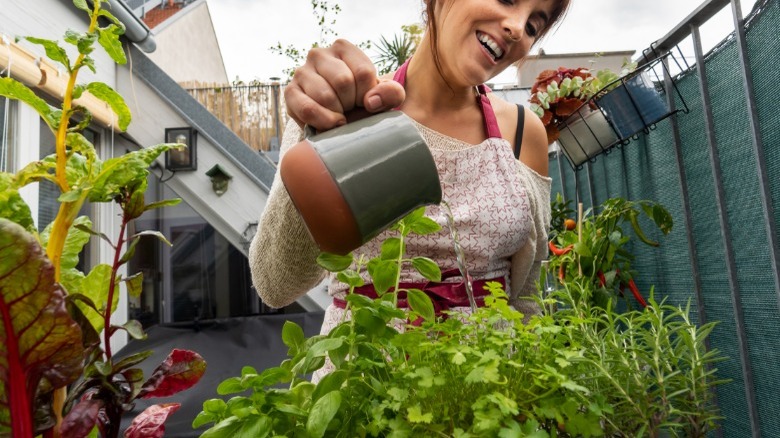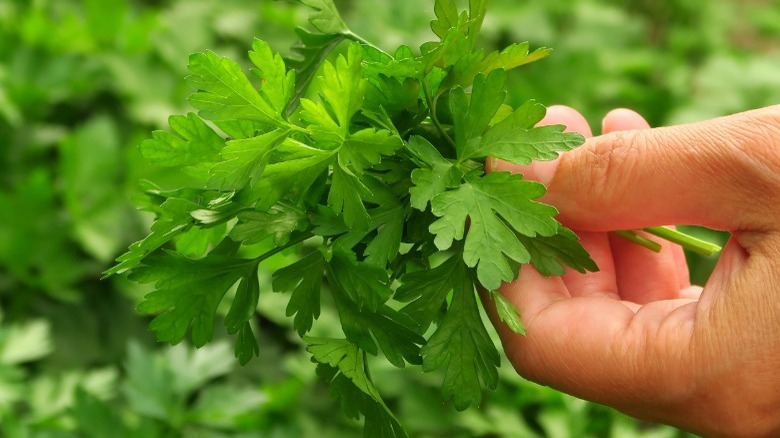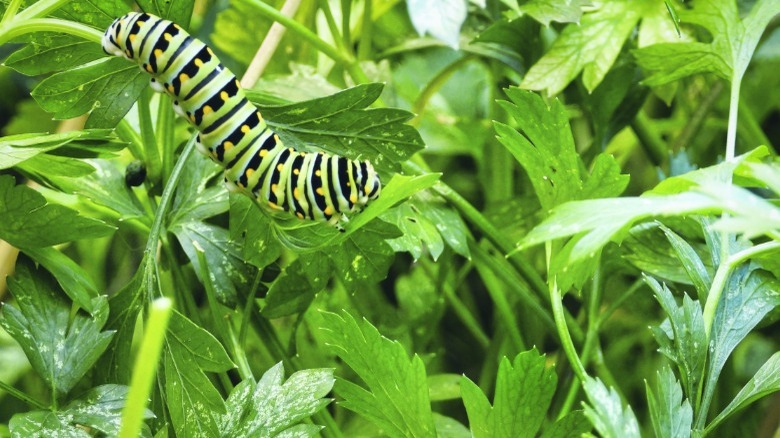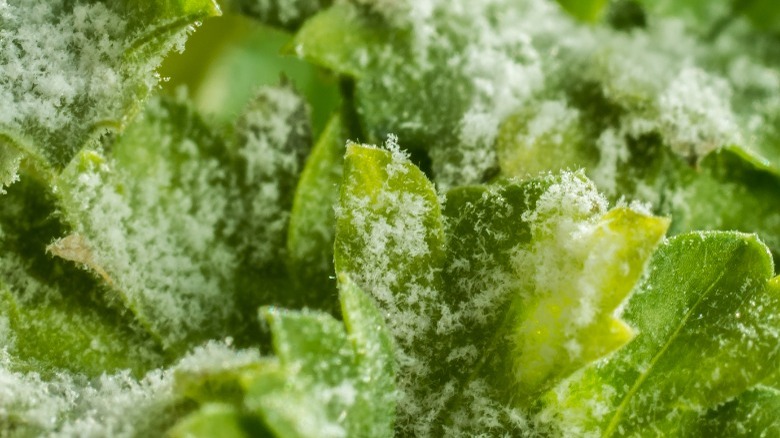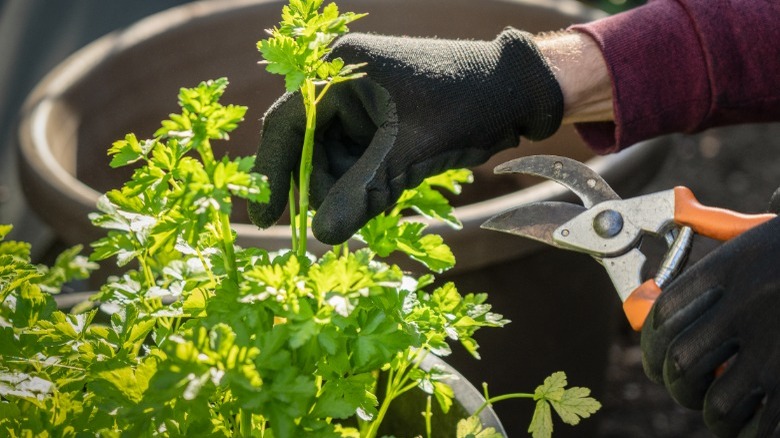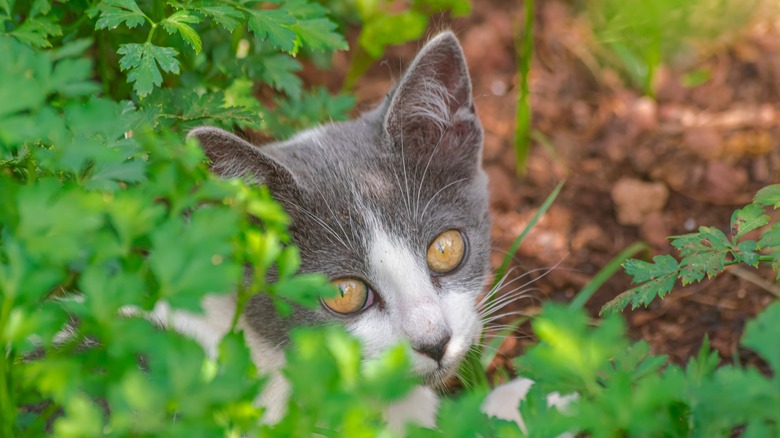How To Grow And Care For Your Own Parsley Plant
Many dishes get their flavor from parsley, which is easy to grow at home. It's a member of the carrot family and can be grown indoors and outdoors. But parsley only shows its best output every other year because it's a biennial, not an annual. After a year of solid performance, these plants produce flowers and less flavorful leaves the following season. This is why many growers pull them up by the roots after harvest and plant new ones.
Freshly picked parsley has an earthy, peppery taste with notes of nutmeg and clove but some describe the taste as bitter. Parsley is a great garden helper because it's thought to make roses smell better, and It can draw insects like aphids away from other nearby plants. This green herb is also a good companion plant for asparagus, peppers, tomatoes, and pears.
If you're used to buying jarred, dried parsley, switch it up and try growing a fresh plant of your own. Not only does it add color to your food, but it's also a cheerful pop of greenery in your home or yard. When growing the herb indoors, put it in a charming pot to add culinary character to your kitchen windowsill. And outdoors, it can be beautiful in its own container or combined with flowers or other herbs in a hanging basket. No matter where you choose to place your parsley crop, here are some tips that can help guarantee growing success.
Choose a variety of parsley
The two most common kinds of parsley used in kitchens are curly and Italian flat-leaf and the names describe each one perfectly. Curly parsley has triangular, dark green leaves that sport nicely ruffled edges. This parsley variety grows up to 1 foot tall and wide but if you plant several of them together, you won't be able to tell them apart because they spread out into dense clumps. Curly parsley does well in pots and garden beds.
Italian flat-leaf parsley looks noticeably different from its curly cousin. It grows to approximately the same height and width and also has triangular dark green leaves, but those are broad and flat with jagged edges. One of the other common kinds of parsley is Japanese parsley. This is similar to Italian parsley but harder to find in the U.S. So is Hamburg parsley with its longer leaves that look like the ones you see on ferns. And if you dig one up you'll see that its roots almost look like white carrots. Those roots are edible, with a taste that's been compared to celery. This parsley is found more often in Europe than in America.
Best soil for parsley
Parsley plants can be a bit picky about their soil and do best in slightly acidic ones. This means that the soil's pH should be in the 6.0 range. For the best results, you'll also need to plant them in rich, well-draining soil. So how can you tell what the soil's acidity is? Through soil pH testing kits. These measure the levels of nutrients, organic matter, and acidity in the ground. They can often be found at garden centers and area college extension programs. The kits are easy to use and once they're analyzed, you'll receive recommendations on what to add to the soil. All you need to do is dig down about 6 to 8 inches in several different spots in the garden bed. The soil gets collected, mixed in a plastic bag, and sent off for analysis.
The testing agency will send you detailed information about the soil and you may be advised to add things like compost, lime, or nitrogen. So even though your soil might not be perfect for parsley plants, this kind of helpful advice will put you on the right track. A 5-10-5 fertilizer product can also be recommended for parsley grown in garden beds, but liquid fertilizers can be used on ones grown in outdoor containers.
Light conditions for growing parsley
Herbs like parsley need a good amount of outside light to grow to their full potential. Parsley does best with six hours of sun per day. When parsley plants don't get adequate light, the stems can get too long and the leaves become deformed. So while no one can control cloudy weather, planting locations can be strategically chosen. Don't put your parsley under a tree, beneath a deck, or in any other shaded area. The second-best choice is indirect sunlight, and that can be fine as long as the temperatures are usually in that 50- to 70-degree range.
What about too much sun, though? Parsley can usually take up to eight hours of sun in one day but excessive light can cause problems. If the sun has been punishing the ground and temperatures are consistently high, consider protecting your parsley plants with a sun umbrella. Mature parsley plants are more tolerant of bright sunlight, but check the plants and soil for dryness. In addition to the umbrella's shade, the plants may need to be watered more frequently.
Planting parsley outdoors
You can sow parsley seeds into the ground, start with young plants, or plant the seeds indoors first. Direct planting into the ground is often best because the taproots are long and sensitive and might not appreciate being transplanted. Parsley is notoriously slow to germinate so you'll want to get the seeds into the dirt three to four weeks before the last spring frost – the optimum soil temperature is 70 degrees, but it can be up to 20 degrees lower. The seeds can be planted ¼ inch down into moist soil, keeping them about 6 to 8 inches apart. Cover them lightly with soil and keep the area moist until the seedlings start to peep from the ground. These look like grass at first, so don't be tempted to pull them out.
To start seeds indoors, use plug trays or peat pots. Fill these with a good seed-starting mix and sow a few seeds in each, down about 4 inches. Top them off with about ¼ inch of soil and move them to a sunny window or place them under grow lights. You should see the seedlings sprout in about two to four weeks, whether they are inside or outdoors. Gradually accustom indoor seedlings to garden conditions by placing them outside for a few hours per day, increasing the amount daily, through a process called hardening. When the seedlings seem tough and have at least three leaves, transplant them into the ground or an outdoor container.
Growing parsley indoors
Parsley can thrive indoors with the right growing conditions. Since these herbs have long taproots, the container you choose should be deep enough to accommodate them. A 2-gallon pot should be sufficient, as long as it's wide enough as the plants can spread out farther than you might think. The type of soil used is just as important since garden dirt or straight potting soil won't do the trick. Parsley gets its flavor from rich organic matter in the soil, so you'll want to replicate that for its new home. All you have to do is add compost or organic fertilizer and mix it in. Take care not to add too much nitrogen because that can impact the parsley's flavor.
The soil also needs to stay loose because if it's too dense, the roots will have nowhere to go. A great thing about growing parsley indoors is the option of moving it to different locations. If it's drying out from too much sun, just move it to another window. Indoor parsley can also become leggy, meaning there are too many long stalks and not enough leaves. This can be caused by uneven light sources, so rotate the plants now and then.
How to water parsley
Herbs can tolerate moderately dry soil but the watering frequency for parsley depends on the growing conditions and rainfall. Unless the weather outside has been very sunny and dry, you can get away with watering these herbs every few days. Seedlings will need to be watered more frequently, and mature parsley plants need less moisture. Always check the soil before watering because if it's very wet or has pooled water the plants could be harmed. You can also stick a finger a few inches down into the soil to see dry how it feels.
When watering outdoor parsley plants, don't spray them with too much force. They can be watered from above as long as the hose is on the lowest pressure setting. An even better idea is to water the ground instead of leaves. That way, you'll be protecting the plant from viruses and fungal diseases. Outdoor potted parsley plants can be watered several times a week, and ones grown indoors won't need to be watered quite as much. Newly planted parsley seeds should be watered immediately and every one to two days afterward.
These are guidelines to keep in mind but your parsley plant will let you know when it is thirsty or drowning in moisture. Dry plants may have browned leaves and could stop growing, and overwatered ones might have overly soft stems, yellow leaves, and droopiness. If you notice the symptoms, remove the damaged leaves and adjust the watering schedule accordingly.
When is parsley ready to be picked?
We know how hard it can be to wait for parsley to ripen but the right timing guarantees the best flavor. This averages about 75 days after planting the seeds. Hold off until the plants are about 8 inches tall and are full of deep green, healthy-appearing leaves with three segments each. If you need a lot of parsley at a time, a plant can be cut down almost to the ground. It should spring back with another full bounty of leaves, but don't do a major cutting like this more than three times a year.
To remove the leaves, pick or cut them from the outermost stems. And unless you're taking them all, leave the innermost ones alone because parsley stems grow out from the center. After you've been growing these plants for a while, you'll see that the outer leaves fade and turn yellow first. If you won't be using the fresh parsley right away don't cut as far down on the stalks, place the cuttings in water, and refrigerate them until ready. They can also be dried on low heat in the oven or frozen but the parsley won't taste as fresh.
Dealing with pests
Nothing's more frustrating than going outside to harvest fresh parsley leaves and seeing that most of the tasty foliage has been devoured by uninvited guests. Certain worms and insects can wreak havoc on parsley plants. Aphids are drawn to these herbs and have small, soft, green, or yellow bodies. An infestation could lead to leaf necrosis and the bugs leave a sticky residue that can develop into mold. Parsley is also attractive to leafminers, moth-like cabbage loopers, and click beetles. But that's not all. Cutworms and armyworms can be found ingesting parsley plant leaves and juices. Black swallowtail caterpillars are also fans but you won't want to kill these because they pollinate plants and turn into beautiful butterflies. Instead, remove them by hand and relocate the plants.
Aphids can be sprayed off with hoses or treated with insecticidal soaps and oils and pesticides are effective on cabbage loopers. Other chemicals can eradicate other insects and worms, so take photos of the invaders and take them to your local garden center. Only use recommended products that are safe for food and always wash your parsley thoroughly before using it.
Common parsley diseases and cures
Many parsley diseases are caused by environmental factors or fungi. One in the first grouping comes from overfertilization and is known as soluble salt injury. This happens when excess salt in fertilized soil causes crystals to form on the soil surface or plant container. You can try flushing out the soil with water for about 20 minutes. If that doesn't work, the parsley can be transferred to another pot or garden bed that has freshly prepared soil. If an indoor parsley plant develops pale tan spots or rings it could have a cold water injury, a disease seen more often in the wintertime. To prevent this problem, keep the foliage dry and only hydrate the soil with room-temperature water.
Moving on to fungi, these unpleasant diseases can be prevented by proper spacing and directing water streams away from the leaves. It's also wise to keep the beds weeded and free of debris. Fungi symptoms include brown or tan spots and small black dots, and a fuzzy white coating is indicative of powdery mildew. Root and crown rot can kill parsley plants, and presents with dark, water-soaked roots and lesions. You can remove affected leaves but when fungal diseases take over parsley plants, it's often best to pull them out. It's hard for them to recover from fungi and the disease can easily spread to their garden bed neighbors.
Trimming parsley
Parsley is one of those herbs that can get out of control so you may need to trim it back once in a while if it's getting in the way of other plants. Harvesting it regularly during the growing season should keep it in decent shape. But keep in mind that it only takes two to three weeks for the stems to grow back completely. If leggy stems are preventing younger ones from thriving, feel free to snip those off to let in more light. You'll want to leave about an inch on each of the leggy stems so they can start over. Also take out overly wide stems, ones that are 8 inches or longer, and older, tough ones. Don't be too enthusiastic about this because if you cut off too many stems, the plant might not survive.
Since parsley plants are biennial, they produce flowers in their second growing seasons. When that happens, just pinch off the yellow blooms and then cut the plants down. They can be protected during cold winter weather with a layer of gardening mulch, or you can cover them up with a tarp. If they're growing in outdoor pots, you can bring them inside for the winter or just plant new ones the following spring.
Is parsley harmful to pets?
This seems to be a bit of a gray area. Some sources claim that small amounts of parsley can freshen a dog's breath while others claim that it's toxic for dogs, cats, and horses. Why tempt fate? Play it safe and keep Fido and Fluffy far away from your parsley plants. According to the ASPCA, this plant is toxic for cats and dogs so the parsley will need to be placed far out of their reach. This includes potted indoor containers plus any growing outside on your property.
Four-legged friends can be nosy, so what are the best ways to keep them away from parsley plants? The most obvious one is to keep them out of reach. Putting indoor pots on high ledges works for dogs, but likely not cats. Outdoor fences can work but can be inconvenient and expensive. You can try placing coffee grounds and citrus peels near the plants since many pets are turned off by those smells. Another suggestion is to plant marigolds and citronella (mosquito plants) near your parsley since cats and dogs don't like those either. They're also turned off by thorny plants, so a strategically-placed rosebush can also serve as a deterrent.
